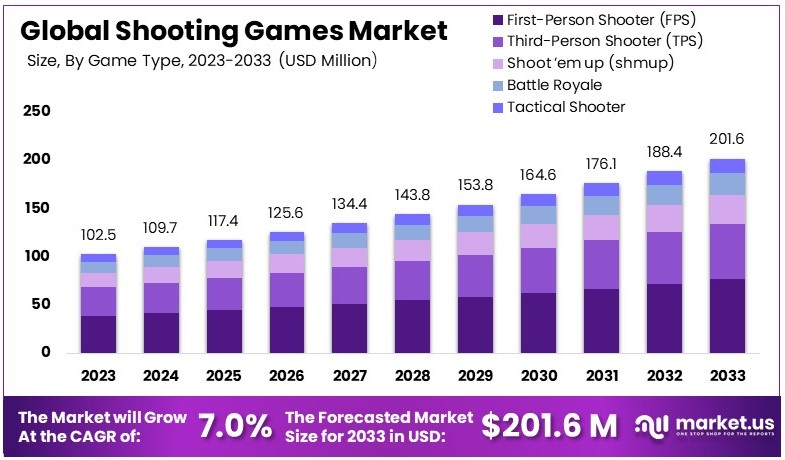Shooting Games Market to hit USD 201.6 Million by 2033
Updated · Oct 07, 2025

WHAT WE HAVE ON THIS PAGE
Introduction
The global shooting games market is expanding steadily, growing from USD 102.5 million in 2023 to an estimated USD 201.6 million by 2033. This reflects a compound annual growth rate of 7.0% during the forecast period from 2024 to 2033. The rise is being fueled by increasing demand for immersive gaming experiences, growth in esports, and advancements in virtual reality and mobile platforms that continue to attract new players.
In 2023, North America emerged as the leading region, capturing a 31% share and generating about USD 31.78 million in revenue. The region’s dominance is supported by a strong gaming culture, widespread console and PC adoption, and the presence of major developers driving innovation in the shooting games genre.

The shooting games market is a key segment of the global video game industry, focusing on games where players engage in combat using firearms or similar weapons. These games range from first-person shooters to battle royales and are available across multiple platforms including mobile devices, PCs, and gaming consoles. The genre is highly popular among young adults due to its fast-paced action and competitive gameplay. Its global appeal is further strengthened by the rise of esports, online multiplayer modes, and the growing accessibility of gaming devices, which have expanded the player base significantly.
Top driving factors in the shooting games market include technological advancements such as improved graphics, immersive sound design, and realistic physics engines. These elements create engaging experiences that attract wider audiences, especially in Asia Pacific where nearly half the market share was held as of recent years. The rise of esports and competitive gaming platforms also play a substantial role by creating visibility and monetization opportunities. Additionally, the increasing use of mobile devices for gaming and the expansion of online multiplayer modes encourage ongoing player engagement and retention.
Demand analysis reveals a wide and growing audience spanning casual players to professional esports athletes. The appeal is broad due to the social aspects of multiplayer gaming and the variety of game modes offered. Market growth is accelerated by the expansion of mobile gaming, which makes shooting games available on the go, and the adoption of cross-platform gaming that allows interaction between players on different devices. This social connectivity has boosted monthly active users by over 30% in some regions over recent years.
Key Insight Summary
- The market was valued at USD 102.5 million in 2023 and is projected to reach USD 201.6 million by 2033, growing at a CAGR of 7.0%.
- By game type, First-Person Shooter (FPS) led with 38% share in 2023, driven by its immersive and engaging gameplay experience.
- By platform, Console gaming dominated with 40%, supported by its established user base and advanced hardware features.
- Regionally, North America led with 31% share, generating about USD 31.78 million in 2023, fueled by high consumer spending and strong gaming popularity.
Role of generative AI
The role of generative AI in shooting games has become increasingly significant by 2025. Generative AI powers dynamic and adaptive game environments, enabling the creation of complex open worlds, personalized quests, and autonomous non-player characters (NPCs) that respond realistically to player actions.
This technology helps generate detailed 3D models, lifelike dialogues, and evolving storylines without requiring large datasets for training, making advanced AI tools accessible even for smaller developers. Recent industry insights show AI’s integration into procedural level design and narrative generation enhances immersion and replay value, with some shooters using AI-driven NPCs that change their motivations over time. The impact is clear, as AI shifts from experimental to a core element in game design, dramatically improving player engagement and creative possibilities.
Emerging trends
Emerging trends in shooting games include a strong move toward cross-platform play, cloud gaming, and incorporation of virtual and augmented reality. Players increasingly demand seamless gameplay across devices, pushing developers to innovate their multiplayer systems. Cloud gaming is making high-quality shooters accessible without expensive hardware, widening the player base.
VR and AR technologies are bringing new levels of immersion to shooting games, creating more engaging user experiences. Additionally, simple “hyper-casual” shooter games are capturing attention, driven by the mobile gaming boom and a preference for quick-play sessions. These trends signal a more connected, accessible, and immersive future for shooting games.
Growth factors
Growth factors fueling the shooting game market are chiefly tied to technological progress and changes in player behavior. Advancements in graphics and game engines have made highly realistic visuals and physics standard expectations. The rapid expansion of mobile gaming, coupled with affordable devices and high-speed internet, has especially accelerated growth.
The free-to-play model has broadened access while offering continuous revenue through microtransactions. Esports and live streaming also play a major role, increasing player engagement and fostering vibrant communities around shooter titles. High-speed networks like 5G have further enhanced online multiplayer experiences, essential for shooter games’ popularity.
Driver Analysis
Growing Popularity of Online Multiplayer and Esports
The shooting games market is driven significantly by the rise of online multiplayer platforms and competitive esports scenes. These games offer players interactive and competitive gameplay, which keeps users engaged for longer periods. The multiplayer aspect connects players worldwide, creating communities and increasing game longevity. For instance, games like Call of Duty and Counter-Strike 2 maintain hundreds of thousands of daily active players due to their strong online multiplayer features. The esports boom further fuels this driver, as large-scale tournaments and increasing prize pools make shooting games a staple in competitive gaming entertainment.
This popularity not only increases player engagement but also generates recurring revenue streams through in-game purchases and event sponsorships. The accessibility of these multiplayer shooter games across various platforms such as PC, consoles, and mobile devices broadens the user base. This trend helps developers extend their reach internationally, especially in regions with strong gaming cultures, such as Asia-Pacific and North America, supporting steady market growth.
Restraint Analysis
Regulatory Restrictions and High Development Costs
The shooting games market faces restraints from regulatory limits on violent content and the high costs of game development. Many countries enforce strict laws restricting the availability of shooting games with intense violence to protect younger audiences. For example, China has introduced limits on the amount of time minors can spend gaming, which directly affects market growth in such regions. These regulations can reduce the potential player base and limit game sales in specific markets.
Alongside regulations, the cost of producing top-quality AAA shooting games is very high. Developing realistic graphics, complex gameplay, and immersive environments requires significant investment, making it harder for smaller studios to compete. Economic challenges like inflation or downturns may force companies to scale back budgets, delaying releases or updates. Additionally, limited access to high-performance gaming hardware in emerging markets restricts growth opportunities further.
Opportunity Analysis
Virtual Reality and Mobile Gaming Expansion
One of the most promising opportunities in the shooting games market is the expansion of virtual reality (VR) and augmented reality (AR) technologies. These provide immersive gaming experiences, giving players a more engaging and interactive feel. As VR and AR continue to improve and become more affordable, game developers can tap into new gameplay mechanics and premium game modes that attract diverse users. For instance, VR shooter games are gaining traction as they bring players closer to realistic combat scenarios, encouraging further investment.
Another major opportunity lies in the growth of mobile gaming. The widespread use of smartphones allows developers to reach a massive audience globally. Mobile-optimized shooting games help grow the player base by providing accessible, anytime play. The integration of in-game monetization through cosmetic items, skins, and battle passes creates sustained revenue streams. The increasing penetration of cloud gaming also reduces the need for costly hardware, further expanding market reach in developing regions.
Challenge Analysis
High Competition and Security Concerns
The shooting games market faces significant challenges due to intense competition and security issues. Large developers dominate the space with established franchises, making it difficult for smaller companies to gain visibility and market share. Keeping players engaged over time is a constant challenge as users expect fresh content and unique gameplay experiences to prevent fatigue. This requires continuous innovation and investment from game creators.
Security concerns are increasingly prominent, especially in online shooter games. Issues like cheating, hacking, and data breaches undermine the player experience and trust in game providers. Addressing these requires robust anti-cheat systems and cybersecurity measures, which can be costly and complex. Furthermore, varying platform standards and device fragmentation complicate delivering consistent gameplay across different environments. These challenges add operational burdens and may affect player retention and profitability.
Key Market Segments
By Game Type
- First-Person Shooter (FPS)
- Third-Person Shooter (TPS)
- Shoot ’em up (shmup)
- Battle Royale
- Tactical Shooter
By Platform
- PC (Personal Computer)
- Console
- Mobile
- Other Platforms
Top Key Players in the Market
- Ubisoft
- Gameloft (Vivendi)
- Valve Corporation
- Krafton
- Nexon
- Activision Blizzard
- Rockstar Games
- Other Key Players
Read More – https://market.us/report/shooting-games-market/
Sources

Joseph D'Souza started Techno Trenz as a personal project to share statistics, expert analysis, product reviews, and tech gadget experiences. It grew into a full-scale tech blog focused on Technology and it's trends. Since its founding in 2020, Techno Trenz has become a top source for tech news. The blog provides detailed, well-researched statistics, facts, charts, and graphs, all verified by experts. The goal is to explain technological innovations and scientific discoveries in a clear and understandable way.










